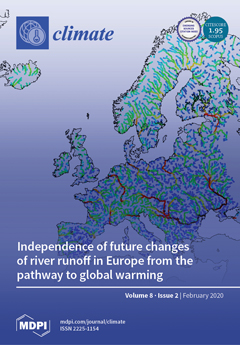In this study, the effects of climate change on precipitation and the maximum daily temperature (T
max) at two USA locations that have different climates—the Travis Airforce Base (AFB) in California [38.27° N, 121.93° W] and Fort Bragg (FBR) in North Carolina
[...] Read more.
In this study, the effects of climate change on precipitation and the maximum daily temperature (T
max) at two USA locations that have different climates—the Travis Airforce Base (AFB) in California [38.27° N, 121.93° W] and Fort Bragg (FBR) in North Carolina [35.14 N, 79.00 W]—are analyzed. The effects of climate change on central tendency, tail distributions, and both auto- and cross-covariance structures in precipitation and T
max fields for three time periods in the 21st century centered on the years 2020, 2050, and 2100 were analyzed. It was found that, on average, T
max under the Representative Concentration Pathway (RCP) 4.5 emission scenario is projected to increase for the years 2020, 2050, and 2100 by 1.1, 2.0, and 2.2 °C, respectively, for AFB, and 0.9, 1.2, and 1.6 °C, respectively, for FBR, while under the RCP8.5 emission scenario T
max will increase by 1.1, 1.9, and 2.7 °C, respectively, for AFB, and 0.1, 1.5, and 2.2 °C, respectively, for FBR. The climate change signal in precipitation is weak. The results show that, under different emission scenarios, events considered to be within 1% of the most extreme events in the past will become ~13–30 times more frequent for T
max, ~and 0.05–3 times more frequent for precipitation in both locations. Several analytical methods were deployed in a sequence, creating an easily scalable framework for similar analyses in the future.
Full article





